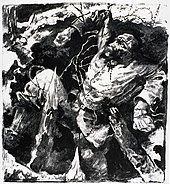Willy Jaeckel
Willy Jaeckel (born February 10, 1888 in Breslau , † January 30, 1944 in Berlin in a bombing raid) was a German painter. He is one of the most important representatives of German Expressionism .
Life
From 1906 to 1908 he was a student at the Breslau Art School. From 1908 he studied at the Dresden Academy with Otto Gußmann . In 1913 he moved to Berlin, where in 1915 he became a member of the Berlin Secession , in 1919 a member of the Prussian Academy of the Arts and in 1925 a teacher at the College of Art Education. His style is expressive and decorative; he also opened expressionism to religious subjects. His first important picture, “Kampf”, in which naked muscle men roaring at each other on a wall-sized canvas, was made in 1912. Jaeckel won the “Georg Schlicht Prize” for the “most beautiful German female portrait in 1928”. In 1933 he was appointed associate professor, but he was dismissed after the National Socialists came to power. After protests by his students, he was reinstated. In 1937 some of his pictures were denigrated in the exhibition " Degenerate Art ". His main fresco, a four-part mural for the Bahlsen biscuit factory in Hanover from 1916/1917, was lost in 1944 due to the effects of the war; his studio was destroyed by bombs in 1943.
His diverse work of portraits, nudes, landscapes and still lifes as well as graphics can be found in museums and private collections. His important students include the Darmstadt painter Ricarda Jacobi and Hans Olde's son Hans Olde the Younger .
His final resting place in the Wilmersdorfer Waldfriedhof Stahnsdorf is preserved as an honorary grave of the city of Berlin . Jaeckel's son Peter Jaeckel (1914–1996) was a classical archaeologist, numismatist and collector.
Works (selection)
- 1914 "Bildnis Frau Jaeckel", oil on canvas, 120 × 80.5 cm
- 1915 "Memento 1914/15", portfolio (10 lithographs)
- 1923 "Hochwald (Allgäuer Bergwald)", oil on canvas, 120.5 × 120.5 cm
- 1923 "Geschwister Wilke", oil on canvas, 110 × 150 cm, Märkisches Museum (Berlin)
- 1925 “Girl in a Red Dress”, oil on canvas, 70 × 60 cm
- around 1925 "Stormy mood on the beach of Hiddensee", pastel on cardboard, 48.5 × 64.4 cm, Ahrenshoop Art Museum
- 1928/1930 "Reclining Nude", oil on canvas, 54 × 66 cm, National Gallery (Berlin)
- 1940 “Portrait of the actress Eva Sommer”, pastel
literature
- Jaeckel, Willy . In: Hans Vollmer (Hrsg.): General lexicon of fine artists from antiquity to the present . Founded by Ulrich Thieme and Felix Becker . tape 18 : Hubatsch – Ingouf . EA Seemann, Leipzig 1925, p. 324 .
- Peter Jaeckel : Jaeckel, Willy. In: New German Biography (NDB). Volume 10, Duncker & Humblot, Berlin 1974, ISBN 3-428-00191-5 , p. 263 f. ( Digitized version ).
- Gerhard Strauss (greeting), Harald Olbrich (ed.): Lexicon of art. Architecture, fine arts, applied arts, industrial design, art theory. Volume 3: Greg - conv. Seemann, Leipzig 2004, ISBN 3-86502-084-4 , p. 495 f.
- Wolfgang Maier-Preusker (Hrsg.): Book and portfolio works with graphics of German Expressionism. Catalog accompanying the exhibition in the Hanseatic City of Wismar 2006. Maier-Preusker, Vienna 2006, ISBN 978-3-900208-37-0 .
- Kunstmuseum Ahrenshoop (ed.): “Around us is a day of creation” From the artists' colony to today. Ahrenshoop 2013, ISBN 978-3-9816136-1-2 , p. 120 f.
Web links
- Literature by and about Willy Jaeckel in the catalog of the German National Library
Individual evidence
- ↑ Verena Dollenmaier (Ed.): Glamor! The girl becomes a fine lady: depictions of women in the late Weimar Republic. Seemann Henschel, Leipzig 2008, ISBN 978-3-86502-178-6 , p. 58 ff.
| personal data | |
|---|---|
| SURNAME | Jaeckel, Willy |
| BRIEF DESCRIPTION | German artist |
| DATE OF BIRTH | February 10, 1888 |
| PLACE OF BIRTH | Wroclaw |
| DATE OF DEATH | January 30, 1944 |
| Place of death | Berlin |





